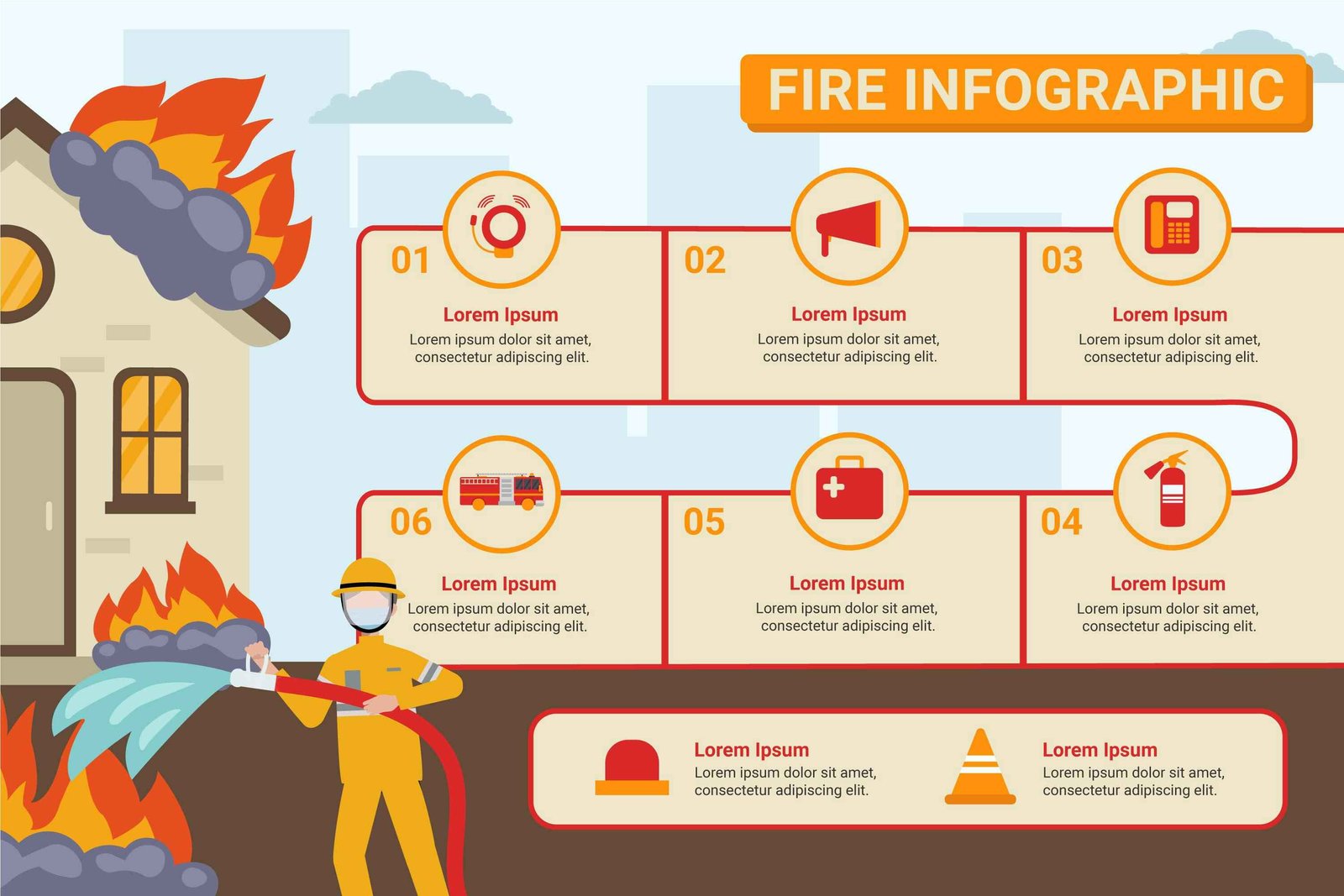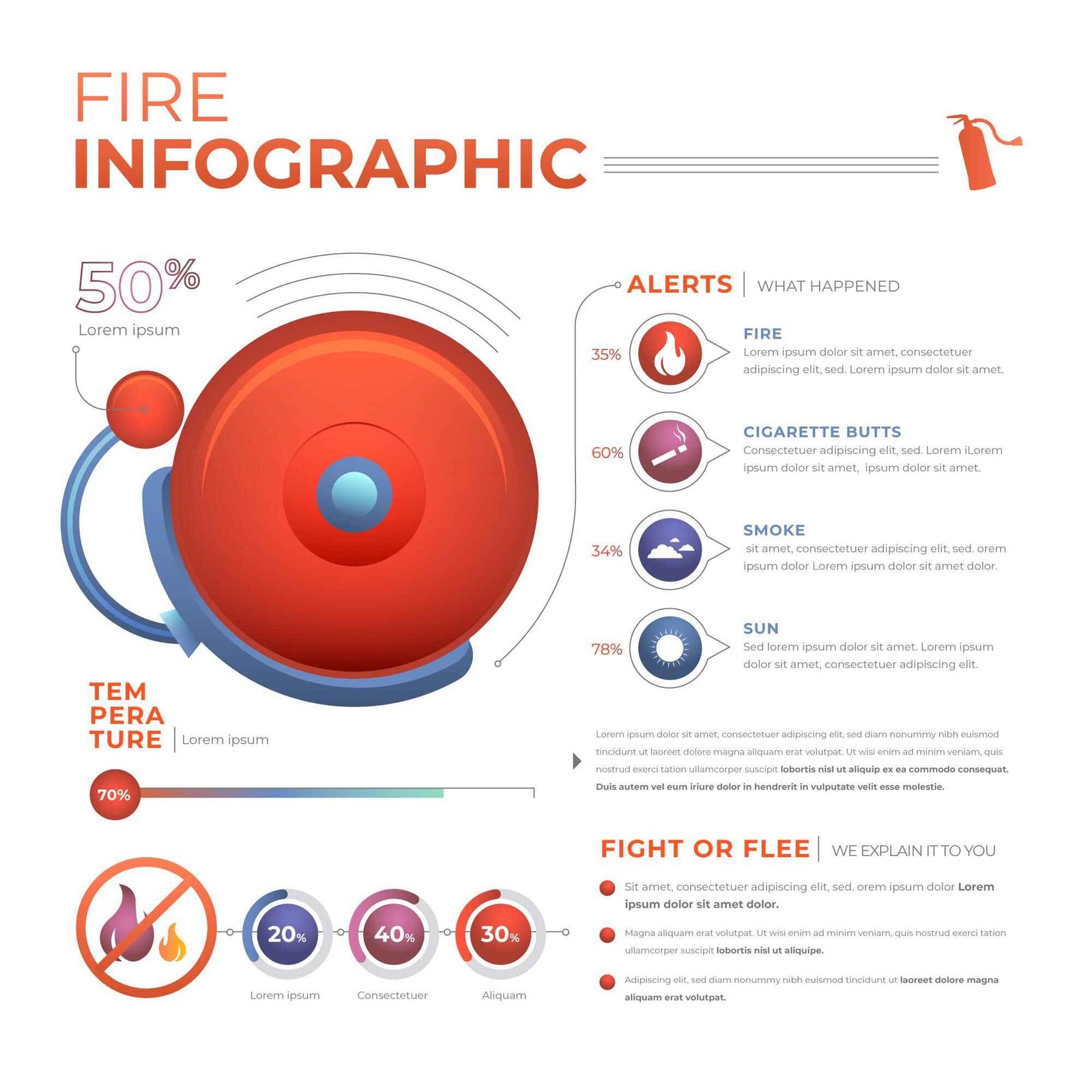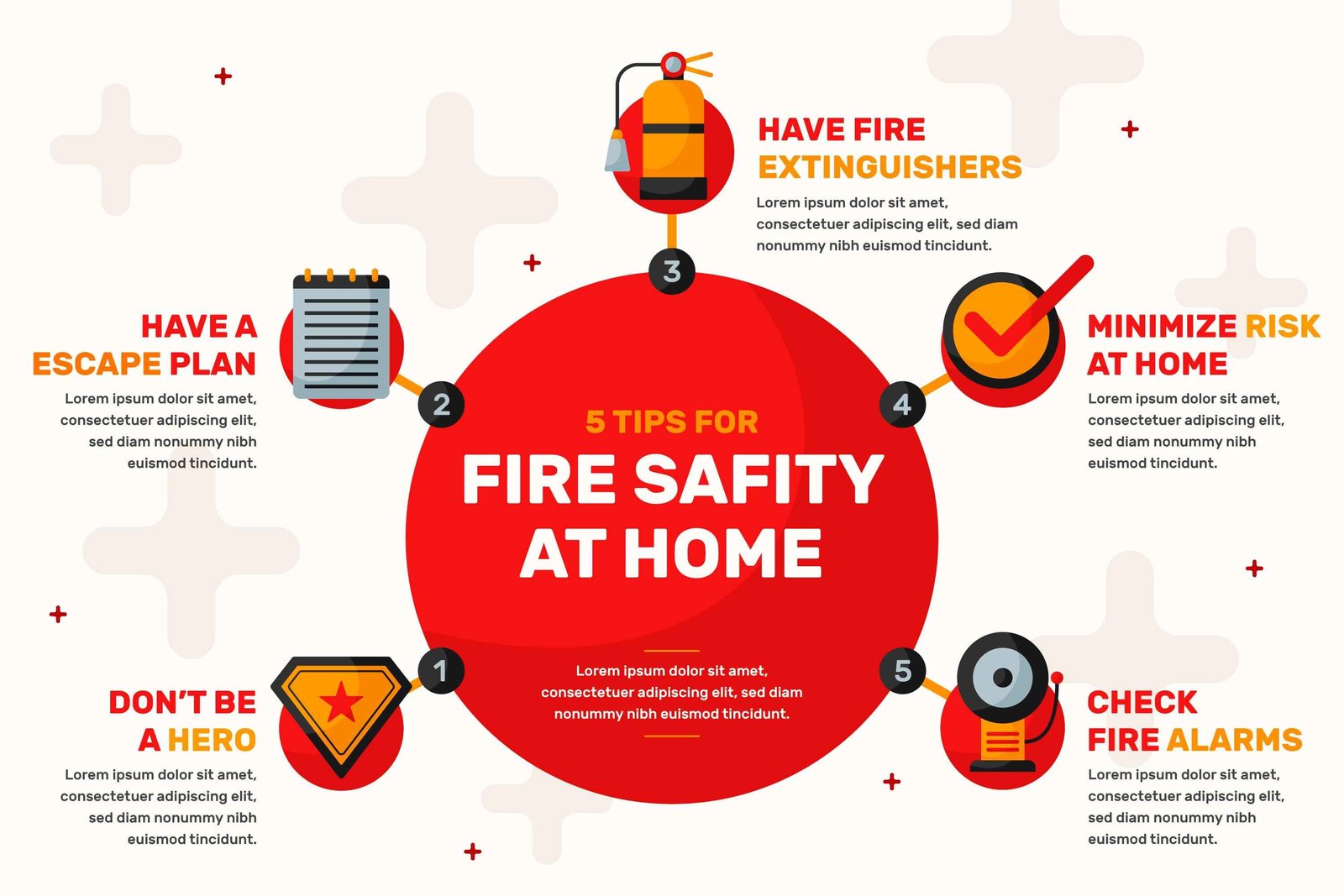About Fire Safety
Fire safety is essential to prevent fires, protect lives, and reduce property damage. Here’s an overview of key fire safety principles:
1. Fire Prevention
- Keep Flammable Materials Away: Store flammable materials like gasoline, chemicals, and paper in safe, secure locations away from heat sources.
- Proper Electrica.... Read More
Fire safety is essential to prevent fires, protect lives, and reduce property damage. Here’s an overview of key fire safety principles:
1. Fire Prevention
- Keep Flammable Materials Away: Store flammable materials like gasoline, chemicals, and paper in safe, secure locations away from heat sources.
- Proper Electrical Maintenance: Regularly inspect electrical wiring and outlets to prevent short circuits and overloads. Avoid overloading sockets and use surge protectors.
- Smoking Precautions: Never smoke indoors or in bed. Ensure cigarette butts are fully extinguished before disposal.
- Kitchen Safety: Stay attentive while cooking. Keep flammable items like towels and paper away from stoves and ovens.
2. Fire Detection
- Smoke Alarms: Install smoke alarms on every level of your home or building, particularly near bedrooms. Test them monthly and replace batteries annually.
- Carbon Monoxide Detectors: These detect dangerous levels of carbon monoxide, a colorless and odorless gas. Place them near sleeping areas and fuel-burning appliances.
3. Fire Preparedness
- Fire Extinguishers: Keep fire extinguishers in key areas like the kitchen, garage, and near exits. Know how to use them (PASS: Pull, Aim, Squeeze, Sweep).
- Escape Plan: Develop and practice an escape plan with all members of your household or workplace. Identify two exits from every room and designate a meeting spot outside.
- Know Emergency Numbers: Be aware of the local emergency number (e.g., 911 in the U.S.) and ensure everyone knows it.
4. Fire Response
- Evacuate Immediately: If a fire occurs, evacuate the building immediately. Do not try to retrieve valuables or use elevators.
- Stay Low: Smoke rises, so stay low to the ground to avoid inhalation of toxic fumes.
- Close Doors: Close doors behind you as you evacuate to slow the spread of fire and smoke.
- Stop, Drop, and Roll: If your clothes catch fire, stop moving, drop to the ground, and roll to smother the flames.
5. Post-Fire Safety
- Do Not Re-enter: Never re-enter a burning building. Wait for the fire department to declare it safe.
- Check for Hot Spots: After a fire is extinguished, be cautious of hot spots that can reignite. Let professionals handle this.
6. Workplace Fire Safety
- Regular Drills: Conduct fire drills regularly to ensure everyone knows what to do in case of an emergency.
- Emergency Lighting: Ensure that emergency exits are well-lit and free from obstructions.
- Fire Safety Equipment: Maintain all fire safety equipment, including sprinklers, alarms, and extinguishers, in good working condition.
7. Fire Safety Education
- Training: Educate everyone in the household or workplace about fire safety procedures, including how to use a fire extinguisher and the importance of fire drills.
- First Aid: Know basic first aid for burns and smoke inhalation. This knowledge can be crucial in the event of a fire.
Fire safety is everyone’s responsibility, and being proactive can make all the difference in an emergency situation.
Fire safety is essential to prevent fires, protect lives, and reduce property damage. Here’s an overview of key fire safety principles:
1. Fire Prevention
- Keep Flammable Materials Away: Store flammable materials like gasoline, chemicals, and paper in safe, secure locations away from heat sources.
- Proper Electrical Maintenance: Regularly inspect electrical wiring and outlets to prevent short circuits and overloads. Avoid overloading sockets and use surge protectors.
- Smoking Precautions: Never smoke indoors or in bed. Ensure cigarette butts are fully extinguished before disposal.
- Kitchen Safety: Stay attentive while cooking. Keep flammable items like towels and paper away from stoves and ovens.
2. Fire Detection
- Smoke Alarms: Install smoke alarms on every level of your home or building, particularly near bedrooms. Test them monthly and replace batteries annually.
- Carbon Monoxide Detectors: These detect dangerous levels of carbon monoxide, a colorless and odorless gas. Place them near sleeping areas and fuel-burning appliances.
3. Fire Preparedness
- Fire Extinguishers: Keep fire extinguishers in key areas like the kitchen, garage, and near exits. Know how to use them (PASS: Pull, Aim, Squeeze, Sweep).
- Escape Plan: Develop and practice an escape plan with all members of your household or workplace. Identify two exits from every room and designate a meeting spot outside.
- Know Emergency Numbers: Be aware of the local emergency number (e.g., 911 in the U.S.) and ensure everyone knows it.
4. Fire Response
- Evacuate Immediately: If a fire occurs, evacuate the building immediately. Do not try to retrieve valuables or use elevators.
- Stay Low: Smoke rises, so stay low to the ground to avoid inhalation of toxic fumes.
- Close Doors: Close doors behind you as you evacuate to slow the spread of fire and smoke.
- Stop, Drop, and Roll: If your clothes catch fire, stop moving, drop to the ground, and roll to smother the flames.
5. Post-Fire Safety
- Do Not Re-enter: Never re-enter a burning building. Wait for the fire department to declare it safe.
- Check for Hot Spots: After a fire is extinguished, be cautious of hot spots that can reignite. Let professionals handle this.
6. Workplace Fire Safety
- Regular Drills: Conduct fire drills regularly to ensure everyone knows what to do in case of an emergency.
- Emergency Lighting: Ensure that emergency exits are well-lit and free from obstructions.
- Fire Safety Equipment: Maintain all fire safety equipment, including sprinklers, alarms, and extinguishers, in good working condition.
7. Fire Safety Education
- Training: Educate everyone in the household or workplace about fire safety procedures, including how to use a fire extinguisher and the importance of fire drills.
- First Aid: Know basic first aid for burns and smoke inhalation. This knowledge can be crucial in the event of a fire.
Fire safety is everyone’s responsibility, and being proactive can make all the difference in an emergency situation.
Read less

 Podcasts
Podcasts 













.png)










